Long-lasting grid battery
Cheap, long-lasting iron-based batteries could help even out renewable energy supplies and expand the use of clean power.

Key players
ESS, Form Energy
Availability
Now
For a few seconds on a sunny afternoon last April, renewables broke a record for California’s main electric grid, providing enough power to supply 94.5% of demand. The moment was hailed as a milestone on the path to decarbonization. But what happens when the sun sets and the breeze stops?
Handling the fluctuating power production of renewables will require cheap storage for hours or even days at a time. New types of iron-based batteries might be up to the task.
Oregon-based ESS, whose batteries can store energy for between four and 12 hours, launched its first grid-scale projects in 2021. Massachusetts-based Form Energy, which raised $240 million in 2021, has batteries that store power for up to 100 hours. Its first installation will be a one-megawatt pilot plant in Minnesota, slated to be completed in 2023.
Both companies rely on batteries that use iron, one of the most abundant materials on the planet. This means that their offerings could eventually be cheaper than other grid storage candidates, like lithium-ion and vanadium flow batteries. Form says its batteries could ultimately cost just $20 per kilowatt-hour, lower than even optimistic projections for lithium-ion batteries in the next several decades.
There are still challenges to address: iron batteries typically have low efficiency, meaning a good fraction of the energy that’s put into them can’t be recovered. Unwanted side reactions can also degrade them over time. But if iron-based batteries can be deployed widely, at a low enough cost, they could help power more of the world with renewable energy.
As part of our 10 Breakthrough Technologies series, learn about ESS's ambitious plans to install iron batteries for grid storage around the world.
Deep Dive
Climate change and energy

This rare earth metal shows us the future of our planet’s resources
The story of neodymium reveals many of the challenges we’ll likely face across the supply chain in the coming century and beyond.

Andrew Ng’s new model lets you play around with solar geoengineering to see what would happen
The climate emulator invites you to explore the controversial climate intervention. I gave it a whirl.

Want to understand the future of technology? Take a look at this one obscure metal.
Here’s what neodymium can tell us about the next century of material demand.
Stay connected
Get the latest updates from
MIT Technology Review
Discover special offers, top stories, upcoming events, and more.
